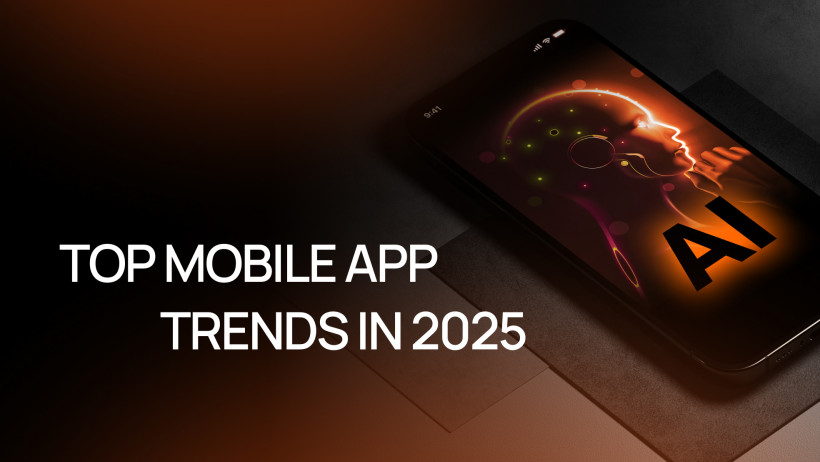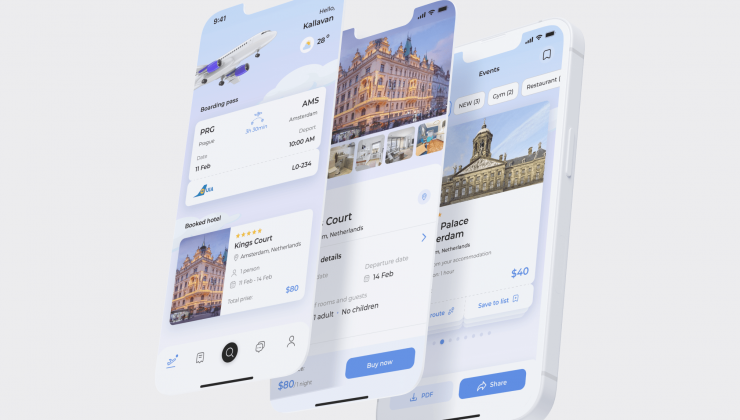Today, when developing mobile software, it’s impossible to limit it to basic functionality. Users expect end-to-end mobile app personalization that minimizes cognitive load and enables performing target actions in a couple of taps. And here, you cannot do without using app development trends, which we will actually consider below.
1. AI and Machine Learning Take Over UX
Artificial intelligence is the most promising technology that defines the future of mobile apps – specifically, it can become the basis for a high-quality user experience. ML and AI-powered mobile apps can independently analyze behavior in real time and offer content tailored to the preferences and needs of each specific user (for example, products, services, interface elements, hints, etc.).
Thus, end users receive not just a list of products or articles, but exactly what meets their expectations. This approach provides the mobile application with a sustainable competitive advantage in the niches of eCommerce, fintech, healthcare, and media, where user attention retention and LTV growth directly depend on the recommendation accuracy and relevance.
As for the technology stack that we use when implementing AI and ML solutions, it includes such tools as TensorFlow Lite, Core ML, and Firebase ML.
2. Voice Interfaces and Conversational UI
Voice interfaces are no longer considered an attribute of only niche, WCAG 2.2-compliant solutions; today, their implementation boosts the usability of any software aimed at a wide audience. Moreover, thanks to the development of NLP technologies, mobile apps that combine voice and manual control not only recognize human speech but also understand its context, thus maintaining human-like dialogues with end users.
This feature is especially effective when using the application “on the go” – for example, when driving and/or controlling IoT systems. In these cases, the ability to use voice commands becomes the most convenient channel for interacting with the UI.
The tools that have proven themselves best in implementing voice interface in apps include Google Dialogflow, Amazon Lex, Microsoft Bot Framework, and OpenAI Whisper.
3. AR & VR Integration for Immersive Experiences

As the hottest trends in mobile UX, AR and VR have gone beyond the gaming industry. For example, in retail, AR/VR integration can be used to implement virtual fitting rooms, in the educational sector – to create simulators with real-life scenarios, and in healthcare – to build three-dimensional educational manuals with demonstrations of internal organs.
In general, AR and VR technologies can reproduce an experience that cannot be replaced by static images or videos. Therefore, the level of involvement that they provide, if implemented correctly, can significantly reduce the barriers to making even the most complex decisions – primarily by providing the opportunity for practical interaction with virtual objects.
In our practice, when developing AR/VR solutions, we have used ARKit, ARCore, Unity, and Unreal Engine – ultimately, the choice of a specific tool depends both on the platform on which the user device is based and on the specific tasks assigned to the app.

4. Rise of Super Apps
The super apps trend is gradually moving beyond the Asian market and becoming a global standard. In fact, super apps are comprehensive platforms where the user can get several services at once: pay for goods or services online, book vehicles, order delivery, etc.
Thus, since super apps cover several user needs at once, they eliminate the need to switch between dozens of stand-alone solutions, which can be indispensable where speed and convenience are crucial – for example, in financial, eCommerce, or transport services (in general, wherever it’s important to get the maximum profit from the app’s monetization).
It’s worth noting that the technology stack may vary from project to project, but the general attributes are as follows: their architectures are modular or microservice-based and imply numerous integrations with third-party service APIs.
5. 5G-Powered Performance and Capabilities
5G-enabled experiences provide what was previously impossible to implement with a poor Internet connection – in particular, streaming of high-resolution video and instant data processing.
In turn, with 5G-compliant software, users get instant loading and the ability to work with large amounts of data without delays, which is indispensable in video streaming platforms, AR applications, logistics software, telemedicine solutions, and services with dynamically updated content.
If we talk about specific tools and approaches for the implementation of 5G solutions, we would like to highlight WebRTC (for streaming) and online rendering.
6. Focus on App Security and Privacy
The growing number of mobile attacks makes security a priority even in applications that do not process and/or store credit card data, medical diagnoses, etc. The problem lies in the improvement of social engineering methods, the mastering of which helps scammers to fish out all the ins and outs of their victims.
That’s why biometric security and the exclusion of personal data abuse (for example, according to the provisions of GDPR/CCPA) are no longer a trend, but a standard of modern software, without which it’s impossible to build long-term relationships with customers. Moreover, in some business niches, even the slightest data leak can undermine the TA’s loyalty and entail legal risks, so the implementation of advanced security mechanisms becomes critically important.
The most common and reliable solutions that guarantee the security of sensitive data are Face ID, Touch ID, OAuth 2.0, and OpenID Connect.
7. Low-Code/No-Code for Faster Prototyping
When bringing a product to the market as early and cheaply as possible (for example, in the MVP format) becomes the basis for its further viability, you cannot do without using low- or no-code platforms. They allow you to test your business ideas on real users without having to hire a full-fledged technical team and spend a huge budget on it.
Generally speaking, this approach is often used by companies at the initial stages of developing their software solutions, as well as when they need to automate internal processes ASAP, and there’s no need for perfect UI customization. After all, the benefit in this case is not in high-quality user experience and anticipating even the smallest needs of the target audience, but in getting a working tool before competitors.
As for the most popular low-code / no-code app builders, we would like to highlight OutSystems, Bubble, and Mendix first of all.
8. Edge Computing Support
Edge computing for mobile apps, due to its independence from centralized servers, is aimed at minimizing latency by being able to process data physically closer to the user.
In fact, such technologies make mobile applications respond instantly, even if they represent large-scale IoT systems or are a part of platforms that handle large data flows. This can also be an optimal solution in the healthcare and transportation sectors, where latency can be too expensive, and it’s not 100% possible to eliminate it through conventional cloud architecture.
As for edge computing tools, these include AWS Greengrass, Azure IoT Edge, and Google Distributed Cloud.
9. Sustainable and Ethical Design
The market is increasingly interested in energy-efficient applications and compliance with ethical standards. Typically, these mobile technology trends are implemented through the program code optimization (so that it consumes the minimum possible amount of computing resources) and the adaptation of interfaces to different user groups (including those with disabilities).
In particular, energy-efficient and inclusive applications create a unique experience that will be appreciated by people for whom adaptability and sustainability in app design are indisputable priorities. This means that by implementing these trends, you can strengthen your target audience’s loyalty and ensure compliance with regulations (if you are about to create software for the public sector).
To develop such solutions, we usually use energy-efficient frameworks such as Flutter and React Native, and also follow the aforementioned WCAG standards for accessibility.
How WEZOM Helps You Stay Ahead of Mobile Trends

We don't just regularly deal with new technologies – we transform them into competitive advantages for businesses. That's why every new project begins with a deep analysis of our clients’ industries and user scenarios. This allows us to offer innovations that will bring your business the fastest ROI and help you achieve the most ambitious goals.
At WEZOM, the development process is built in such a way that the mobile application remains relevant not only today, but also for many years to come – for this, we initially build flexible architectures, ensuring their scalability, integrability, and adaptability to new business models. Thanks to this, you get a product that you won't have to redo from scratch in a year or two.
Conclusion
According to our vision, following the mobile app trends in 2025 is about making a mobile application resistant to market changes and attractive to users for a long time. That’s why, by choosing us, you’ll get a reliable strategic partner who knows how to combine technology and business in the most efficient way. If you need advice on your business idea related to mobile development, feel free to contact us.


